Abstract
The impact of some organic pollutants on some residents of Tanta and Ismailia cities of Egypt through their consumption of vegetables, fruits and fish (Nile tilapia and catfish) was examined. Residues of organochlorine (OCS) and organophosphorus (OPS) as some polychlorinated biphenyls (PCBS) were compared with pesticides as well maximum residue limits (MRLS). Probable health risk to consumers was also assessed. P, P′-DDT, P, P′-DDE, P, P′-DDD, endrin, α-BHC, (lindane), and hexachlorbenzene (HCB) were the most detected organochlorine compounds, but did not exceed MRLs.
However, OPS residues were the most frequently detected contaminants. PCBs congeners 28, 70, 52, and 180 were detected in tilapia fish from Tanta, but congeners 28 and 180 were the only detected congeners in samples collected from Ismailia region. ∑PCBS values in all matrices did not exceed MRLS. Hazard index (HI) exhibited unity for all compounds at 50 the decreasing order: catfish > vegetables > fruits > Nile tilapia in Tanta, while in Ismailia the order was Nile tilapia > fruit > vegetables. Results also revealed that risk values for adults were greater than those of children categories.


Similar content being viewed by others
References
Abd-Allah, A. M. and Ali, H. A. (1994). Residue levels of chlorinated hydrocarbons compounds in fish from El-Max Bay and Maryut Lake, Alexandria. Egypt Toxicol Environ Chem (42):107–14
Abdel-Halim KY (2008) Health risk assessment of heavy metals associated with fish consumption in EDKU region, Egypt. J Pest Cont & EnvironSci 16(1/2):1–16
Abdel-Halim KY, Salama AK, EL-Khateeb EN, Bakry NM (2006) Organophosphorus pollutants (OPP) in aquatic environment at Damietta Governorate, Egypt: implications for monitoring and biomarker responses. Chemosphere 63:1491–1498
Abou-Arab AAK, Abou Donia MA, Mohamed SR, Enab AK (2015) Risk assessment of lead in Egyptian vegetables and fruits from different environments. Int J Biol Bimol Agri Food and Biotechnol Eng 9(3):335–341
Ahmad AK, Shuhaimi-Othman M (2010) Heavy metal concentrations in sediments and fishes from Lake Chini, Pahang, Malaysia. J Biol Sci 10(2):93–100
Berti PR, Receveur O, Chan HM, Kuhnlein HV (1998) Dietary exposure to chemical contaminants from traditional food among adult Dene/Metis in the western Northwest Territories, Canada. Environ Res 76:131–142
Binelli A, Provini A (2003) POPs in edible clams from different Italian and European markets and possible human health risk. Marine Poll Bull 46:879–886
Brinkmann VA Th, De Kok A, Kimbrough RD (ed) (1980) Halogenated biphenyls, terphenyls, naphthalenes, dibenzodioxins and related products. Elsevier/North Holland, Amsterdam, 1
Chourasiya S, Khillare PS, Jyethi DS (2015) Health risk assessment of organochlorine pesticide exposure through dietary intake of vegetables grown in the periurban sites of Delhi, India. Environ Sci Pollut Res 22:5793–5806
D’Mello JPF (2003) Food safety: contaminants and toxins. CABI Publishing, Wallingford/ Cambridge
Dogheim SM, El-Zarka M, Gad Alla SA, El-Saied S, Salama EY, Ayoub MM, Fahmy SM (1996) Monitoring of pesticide residues in human milk, soil, water and food samples collected from Kafr El-Zayat governorate. J Assoc Off Anal Chem 79:111–116
Dogheim SM, Gad Alla SA, El-Marsafy AM (2002) Monitoring of pesticide residues in Egyptian fruits and vegetables in 1996. J Assoc Off Anal Chem 84:519–531
Dorea JG (2008) Persistent, bioaccumulative and toxic substances in fish: human health consideration. Sci Total Environ 400:93–114
Doughtery CP, Holtz SH, Reinert JC, Panyacosit L, Axelrad DA, Woodruff TJ (2000) Dietary exposure to food contaminants across the United States. Environ Res 84:170
El Nemr A, Said TO, Khaled A, El Sikaily A, Abd-Allah AMA (2003) Polychlorinated biphenyls and chlorinated pesticides in mussels collected from the Egyptian Mediterranean Coast. Bull. Environ. Contam. Toxicol. 71(2):290–297
El-Nemr A, Abd-Allah AMA (2004) Organochlorine contamination in some marketable fish in Egypt. Chemosphere 54:1401–1406
Fleming LE, Broad K, Clement A, Dewailly E, Elmir S, Knap A, Pomponi SA, Smith S, Solo Gabriele H, Walsh P (2006) Oceans and human health: emerging public health risk in the marine environment. Mar Pollut Bull 53:545–560
Fries GF (1995) A review of the significance of animal food products as potential pathways of human exposure to dioxins. J Anim Sci 73:1639–1650
Gad Allah S, Mohsen MA, Mohamed AA, Wasfi MT (2013) Dietary Intake of Pesticide Residues in some Egyptian Fruits, J. Appl Sci Res 9(1):965–973
Gomez, KA and Gomez AA (1984). Statistical procedures for agriculture research 2nd ed. John Willy and Sans. New York Polychlorinated biphenyls (PCBs) in the British environment: sinks sources and temporal trends. Environ. Pollut. (85), 131.
Hogsette JA, Koehler PG, and Kaufman PE, (2006). Pesticide safety around animals. http://edis.ifas. Ufl. Edu/IG128.
Holtan, P. (1998). Catfish, channel catfish — flathead catfish. Wisconsin Department of Natural Resource Bureau of Fisheries Management.
IRIS, (2005). Ingestion risk information system, US environmental protection agency, Cincinnati, OH. Accessed at: http://www.epa.gov/iris .
ISO/IEC, (1990). EN 45001, Guide 25, General requirements for the competence of calibration and testing laboratories, Geneva, 1990.
Itanna F (2002) Metals in leafy vegetables grown in Addis Ababa and toxicological implications. Ethiop J Heal Dev 6:295–302
Jiang QT, Lee TKM, Chen K et al (2005) Human health risk assessment of organochlorines associated with fish consumption in a coastal city in China. Environ Pollut 136:155–165
Kutz FW, Strassman SC, Sperling JE (1979) Reviews of environmental contamination and toxicology. Ann N Y Acad Sci 320:60
Lin WX (2002). The compilation of residue limits standards for pesticides and veterinary drugs in foodstuffs in the world. Dalian Maritime University Press; 3–1288.
Loutfy N, Fuerhacker M, Lesueurb C, M Gartner, MT Ahmed, and Mentlerd A, (2008). Pesticide and non-dioxin-like polychlorinated biphenyls (NDL-PCBs) residues in foodstuffs from Ismailia city, Egypt; ISSN 0265–203X print/ISSN 1464–5122 online ©2008 Taylor & Francis. https://doi.org/10.1080/02652030701726618 http://www.informaworld.com.
Ntow WJ, Gijzen HJ, Kelderman P, Drechsel P (2006) Farmer perceptions and pesticide use practices in vegetable production in Ghana. Pest Manag Sci 62(4):356365
Suchan P, Pulkrabova J, Hajslova J, Kocourek V (2004) Pressurized liquid extraction in determination of polychlorinated biphenyl and organochlorine pesticides in fish samples. Anal Chim Acta 520:193–200
Tchounwou BP, Ashour BA, Ragheb DA, Romeh AA (2002) Health risk assessment of pesticide usage in Menia El-Kamh Province of Sharkia Governorate in Egypt. Int J Mol Sci 3(10):1082–1094. https://doi.org/10.3390/i3101082
Tricker AR, Preussmann R (1990) Chemical food contaminants in the initiation of cancer. Proc Nutr Soc 49:133–144
USEPA (1999) Integrated Risk Information System (IRIS) on Carbaryl; National Center for Environmental Assessment. Office of Research and Development, Washington, DC, USA
USEPA, (1985). Development of statistical distributions or ranges of standards factors used in exposure assessments. Office of health and environment assessmnt.
USEPA, (1989). Air superfund national technical guidance services. Vol. IV: proposed for dispersion modeling and air monitoring for superfund air pathway analysis. Interim. Final. Office of air quality planning and standards. Research Triangle Park, NC. EPA/450/1-89/004.
USEPA, (1991). Memorandum from the office of pesticides and toxic substances to office of pesticide programs division director, Washington, DC; 1991.
USEPA, (1996). Soil screening guidance: technical background document. EPA/540/R-95/128. Office of solid waste and emergency response.
USEPA, (2002). Integrated risk information system (electronic data base). U.S. environmental protection agency, Washington DC. Available on line http://www.epa.gov/iris.
USFDA, (2007) Pesticide residue monitoring 2007 report. https://wayback.archiveit.org/7993/20170723033521/https://www.fda.gov/Food/FoodborneIllnessContaminants/Pesticides/ucm169577.htm
Wang N, Yi L, Shi L, Kong D, Cai D, Wang D, Shan Z (2012) Pollution level and human health risk assessment of some pesticides and polychlorinated biphenyls in Nantong of Southeast China. J Environ Sci 24:1854–1860
Zabik ME, Merrill C, Zabik MJ (1982) PCBs and other xenobiotics in raw and cooked carp. Bull Environ Contam Toxicol 28:710–715
Zhou P, Zhao Y, Li J, Wu G, Zhang L, Liu Q, Fan S, Yang X, Li X, Wu Y (2012) Dietary exposure to persistent organochlorine pesticides in 2007 Chinese total diet study. Environ Int 42:152–159
Author information
Authors and Affiliations
Corresponding author
Additional information
Responsible editor: Philippe Garrigues
Rights and permissions
About this article
Cite this article
Issa, A.B., Yassin, K., Loutfy, N. et al. Risk assessment of some organic contaminants: a case study based on food consumption in Tanta and Ismailia cities, Egypt. Environ Sci Pollut Res 25, 34212–34220 (2018). https://doi.org/10.1007/s11356-018-3313-3
Received:
Accepted:
Published:
Issue Date:
DOI: https://doi.org/10.1007/s11356-018-3313-3




